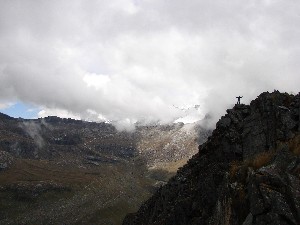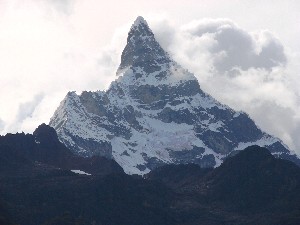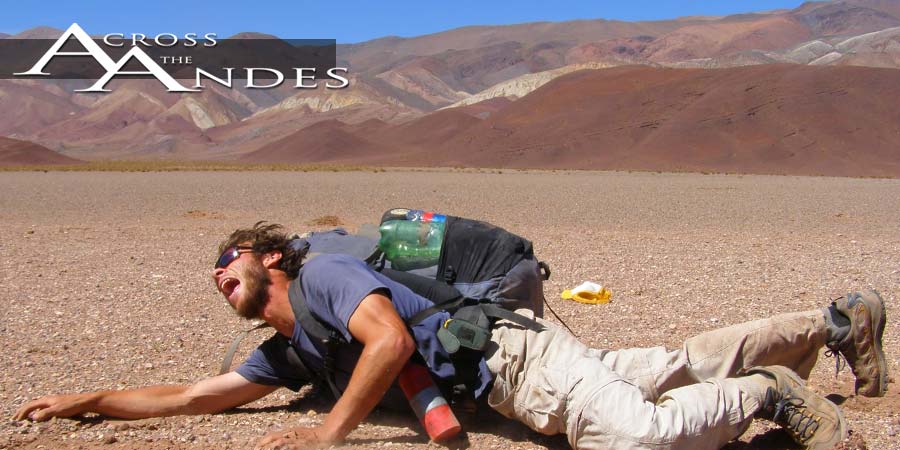The Blanca & Camino Rel Incaico
By Gregg Treinish
December 23, 2006

First of I want to start this update by saying that the length of time since the last update is no indication of the quality of this section. Our expectations were exceptionally high after an incredible summit of Pisco and Thanksgiving at the California Café in Huaraz. The range has continued to exceed our expectations throughout. With only two weeks left in Dave and Jesse’s stay with us, we decided to conquer the northern half of the Cordillera Blanca. For those of you who don´t know, this range is huge. Look at a map of Peru, it takes up a good portion of the country.
Two weeks to do the north would be pushing it and we all knew that
we would have to move relatively quickly in order to get back in time
for Dave and Jesse to catch their flight. We repeated the ever so
thrilling bus ride to the town of Tarica where we had last left our
hike. As Dave and Jesse got their first taste of real Andean culture,
we discovered that we were only the second group of tourists to pass
through town as far back as any of the locals could remember. Spending
the night in the soccer field outside of the local school, we would
climb up and straight into the highest portions of the Peruvian Andes,
so we thought. Sometime during the second day of the hike, Dave came
down with a most interesting case of Travelers Diarrhea, foam and all.
Despite all desperately wanting to continue on, everyone in our group
agreed that the best course of action would be to hike to the nearest
town to find meds and rest. The nearest town (Pomobamba) was a two and
a half day hike out and down, far down. Through an incredibly green
wide open valley we would descend almost 5000 ft. to town, having
picked up a local woman as a guide for a while. She sewed the entire
way down, walking the whole time in rubber clogs.
Two days and a lot of food binging later, Dave was recouped enough and
we were back at it, now climbing from town to get back up and into the
heart of the altura. After a couple of days to get back on track, we
found ourselves sleeping directly below our first glacier on the hike.
We were all praying for a clear morning so that the views from the
15000ft. Paso Pucaraju would be as astonishing as we had been
anticipating. As the sun rose things were looking good. As the
Talliraju glacier high above glowed with orange from the morning
sunlight, we packed up and began the final ascent to the pass. Reaching
the ridge to find that the entire view was socked in with clouds would
have been more disappointing if there weren´t four great friends
sitting in the heart of one of the most incredible places on earth
without anything else in the world to worry about. During our long stay
on top, we did manage to get a few peeks of the surrounding peaks,
enough to leave us contented anyway. We would descend the pass via the
Huaripampa Valley. Three quarters of the way down I was stopped dead in
my tracks. I looked to the right and almost immediately felt a wave of
excitement inside. I simply pointed and said to Dave “look.” The two of
us sat for nearly a half-hour looking at the single greatest thing that
either of us have seen in our backcountry explorations. Rising 6112m
(20 052ft) from behind a very large mountain was Chacraraju. The
pictures surely can explain it far better, but it is the most inspiring
jagged creation that I have ever laid eyes on; I could have sat there
for a life-time just looking. I couldn’t help but wonder if the people
living below, the people of Huaripampa, know. As most if not all of
them never have stepped foot out of the valley, do they really know
that the rest of the world doesn’t look like that? I guess when you
live in a place like this one there really is no reason to leave. So
often throughout this section the four of us would happen upon a remote
high-mountain cabin and say to one another that we could live there.
Life seems to be incredibly simple in a lot of high mountain Peru .
Often we see people watching their sheep, sitting with views we would
walk a lifetime to see, reading a book or sewing. As we wave and
exchange few words, it is continuously clear that simplicity has done
these people well. Twice, sometimes three times a year fields are
tilled by hand or using cattle, as crops grow year round. Cattle,
sheep, and chickens are raised by almost every family providing much of
the food supply. Often the days consist of long walks up to ridge tops
where new grazing lands can be found for the animalitos as they are
called. Water comes as it does for us from the rivers and the rain, and
power really just isn’t needed. Perhaps you will all be able to visit
us someday high up in the Peruvian sierra in our new mud house that our
neighbors helped us to make. After a quick resupply in Yanama, and the
amazing hospitality of the Italian-run Peroqui, we were headed for our
second pass of the section with the hopes of better luck with the
weather.

Passing a lake filled with icebergs (they weren´t that impressive) we climbed high, this time approaching the 4850m (15912ft) Paso Yanayacu. As we had approached this section, I had been growing increasingly fearful as to what might be ahead. The guide book which actually does exist for this section exclaimed, “For those who are afraid of heights, don´t do this hike.” Though not as bad as my father, I am afraid of heights. As we reached the “challenging” part of the hike, it looked really scary from far away. With drops of over 1500 ft below at 90 degree angles and with a cliff wall looming high above, the hike looked much scarier than it actually would prove to be. When I was done exclaiming that I was a bit scared and finally got up the courage to climb to the summit, I quickly realized that the book had greatly exaggerated, and that the climb was really not very scary at all. Still I hugged the wall and avoided looking down as much as possible. Climbing up to the ridge, we were a bit discouraged at the blanket of clouds covering the nearby glaciers, which we were now above parts of. Atop, we were all surprised and elated to find clear views of Chopicalqui, Huscuaran, Contaherbias, Ulta and several other storybook peaks. Finally we could see the greatness we have been traveling in. Really happy with the section, we would descend to town and say our goodbyes after spending the last few days rock climbing near Huaraz. Sad to have our friends leave we would recoup mentally and spiritually for a few days at The Way Inn, a local lodge that a friend we have met here owns. It is an incredible place for anyone planning trips to visit. Newly enlightened, we would head back to the mountains, do a short section to Huari and from there pick up one of the better preserved sections of the 20000km of Incan Trail that runs throughout the Andes. As Deia explained, to walk on the Incan trail feels like we are “part of something much bigger.” It not only feels great to actually have a trail to follow, but the thoughts of so many people so long ago traveling the footpath to Cusco and the most important Machu Pichu really does inspire. Along the way, we would encounter many ruins, some of which were incredibly impressive. In particular, El Tambo Grande struck me, as it was the first of many we came upon that are being inhabited by the descendants of their original constructors. Living very much as his ancestors did nearly 1500 years ago when the ruins were built, Cesar Rojas and family live under thatch roof three to four days walk from the nearest town, and inside of the ruins. Truly a remarkable thing to see, people unchanged, unadulterated by the outside world, people mostly oblivious to the outside world, people very content with life. Wishing we had supplies to stay longer, we continued down three days or so, having arrived near the ruins of Hanuco Viejo which are reportedly the most significant ruins outside of Cusco. We will spend Christmas Eve with friends in Huaraz before returning to the ruins for another few days of Incan Trail Travel. A while back, before the trip I was in the airport somewhere in the U.S when a guy that I had been hanging out with for the night asked me, “What do you think about when you walk that far?” Recently I have been paying a lot of attention to my thoughts and realized that in reality, I don’t think about much. So often my mind is occupied with amazement at the views, with what has become everyday encounters of new things, and with thoughts of how far we have to go until the next hot meal, or until the next shower, that deep ponderings just don’t seem to go very far. What I realized from this with the help of Deia, is that we are learning a lot without realizing it, much like a child learns. We have been traveling through backcountry South America for nearly six months now and probably have changed a ton. I feel like me, I am not aware of many of the changes yet, and don’t think that they will really sink in until our return to “normal” life in the US. I know that I am far more aware of life, far more in touch with people on a global level. I know that priorities have certainly changed, fully exploring the places we visit at the top of the list. I know that I am continuously amazed at the centrality of family in the lives here, often people will remain with their families a lifetime. This has certainly made me evaluate the role of family in my life. There are so many things that are the way they are here, they no longer seem different to us, no longer strike us as life changing, nonetheless there is very little doubt that we will continue to grow and to learn simply from being here, let alone from doing it the way that we are.

I asked Deia sometime during this section how she was feeling about the trip as a whole, about our chances of success and about continuing on for a long long time. We both feel much the same way: really good. As we have further settled into the routine, and become more comfortable as that routine changes or is interrupted, I feel better and better about continuing on. We really have very little idea of how far we have walked at this point though it is undoubtedly approaching 2000 miles, and even less of an idea of how far we have to go, maybe as much as 4000 miles left. This week we will be going to Lima to have a specialist look at Deia’s knees, though we are both nervous as to what he or she might say, we remain committed to the hike, committed to continuing on with the experience however we need to make that happen.
Wishing a very happy holidays to everyone and constantly missing a lot of you, we love getting even the smallest hellos via email or regular mail. Please write. Oh yeah and a shout out to David who I forgot that I promised I would say hello to in the videos.







